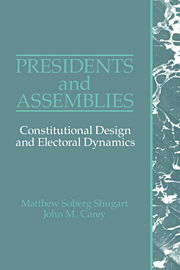Book contents
- Frontmatter
- Contents
- List of tables and figures
- Acknowledgments
- 1 Basic choices in democratic regime types
- 2 Defining regimes with elected presidents
- 3 Criticisms of presidentialism and responses
- 4 The premier-presidential and president-parliamentary experiences
- 5 The constitutional origins of chief executives
- 6 Constitutional limits on separate origin and survival
- 7 Legislative powers of presidents
- 8 Assessing the powers of the presidency
- 9 Electoral dynamics: efficiency and inefficiency
- 10 Electoral rules and the party system
- 11 Electoral cycles and the party system
- 12 Electoral cycles and compatibility between president and assembly
- 13 Conclusions
- Appendix A Electoral rules for one-seat districts and coalition-building incentives
- Appendix B Theoretical explanation for models predicting number of parties in presidential systems
- Bibliography
- Index
8 - Assessing the powers of the presidency
Published online by Cambridge University Press: 05 June 2012
- Frontmatter
- Contents
- List of tables and figures
- Acknowledgments
- 1 Basic choices in democratic regime types
- 2 Defining regimes with elected presidents
- 3 Criticisms of presidentialism and responses
- 4 The premier-presidential and president-parliamentary experiences
- 5 The constitutional origins of chief executives
- 6 Constitutional limits on separate origin and survival
- 7 Legislative powers of presidents
- 8 Assessing the powers of the presidency
- 9 Electoral dynamics: efficiency and inefficiency
- 10 Electoral rules and the party system
- 11 Electoral cycles and the party system
- 12 Electoral cycles and compatibility between president and assembly
- 13 Conclusions
- Appendix A Electoral rules for one-seat districts and coalition-building incentives
- Appendix B Theoretical explanation for models predicting number of parties in presidential systems
- Bibliography
- Index
Summary
In this chapter we undertake a process of assessing just how powerful a president is in constitutional terms. We identify two basic dimensions of presidential power: one concerning power over legislation, the other encompassing nonlegislative powers, including authority over the cabinet and calling of early elections for congress. Additionally, because the latter powers are directly related to the question of separation of powers, we provide a comparison of presidential powers over the composition of cabinets to separation of executive from assembly. There are two main, related lessons we shall be able to draw from this exercise. First, systems that score high on presidential powers, and in particular those that are extreme on presidential legislative powers, are often those systems that have exhibited the greatest trouble with sustaining stable democracy. Second, systems that give the president considerable powers over the composition of the cabinet but also are low on separation of survival of assembly and executive powers likewise tend to be among the “troubled” cases. There are thus left two basic clusters that, we argue, are “safer” for the success of democracy: (1) those with high separation of survival of powers but low presidential legislative powers; and (2) those with low separation of survival but also low presidential authority over the cabinet. These categories happen to be those approximating the (more or less “ideal”) types we have discussed in previous chapters: presidential and premier-presidential, respectively.
- Type
- Chapter
- Information
- Presidents and AssembliesConstitutional Design and Electoral Dynamics, pp. 148 - 166Publisher: Cambridge University PressPrint publication year: 1992
- 1
- Cited by



